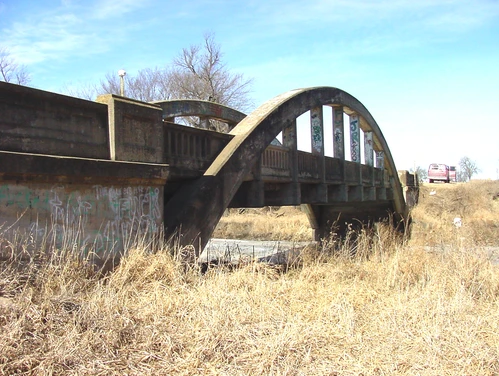- Year constructed: 1916
- Bridge type: Concrete Marsh Arch
- National Register of Historic Places status: Listed
- Length: 102 feet
- Width: 17.5 feet
- Spans: 1
- FHWA: 217370
- Jurisdiction: Kossuth County
- Location: County Road P14 over the east fork of the Des Moines River, 6.9 miles southwest of Swea City, Section 31, T99N-R30W (Swea Township)
Details
Kossuth County, like virtually all of Iowa's counties, adopted the state highway commission's standard designs for its concrete bridges in the 1910s. Most of the county's structures during these years were small-scale slabs or girders, but in 1916 the board of supervisors deviated from this trend on one important span--this concrete arch over the East Fork of the Des Moines River, in the northwestern part of Kossuth County on the Kossuth/Emmet County line. For the Des Moines River Bridge, the county purchased a design from Des Moines Engineer James B. Marsh. Marsh had received a patent for his innovative medium-span arch in 1912. Comprised of two tapered concrete arches that carried the roadway deck between them from hangers, his invention soon became known as the rainbow arch for its distinctive profile. Marsh's design represented the hybridization of continuous concrete and segmental steel arch designs.
The Des Moines River Bridge features a 100-foot span, divided evenly between nine panels. In February 1916 the county contracted with the Marsh Engineering Company to build the single-span arch for $7150.00, of which each county would pay half. Like virtually all of Marsh's bridges, the Des Moines River Bridge used a standardized construction sequence. The abutments and piers were poured first, followed by the arch ribs, hangers and floor beams. Then the intermediate ties, floor slab, wall copings and rails were concreted. Once the formwork for the floor was removed, the intermediate hangers were coated. Because the hangers had to be under full dead load when they were concreted, the forms were struck no less than 10 days or more than 21 days after the slab was poured. Pouring the guardrails later in 1916 completed the bridge. It has functioned in place since that time, without alteration.
The Des Moines River Bridge in Kossuth County is distinguished as one of the longest of the Marsh rainbow arches--a well-preserved example of an indigenous structural type.
Adapted from Zibell and Fraser 1992
Areas Served
- Kossuth
